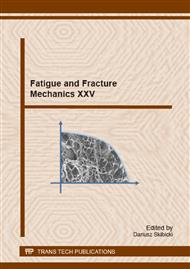p.226
p.232
p.238
p.244
p.249
p.255
p.261
p.267
p.276
Evaluation of the Riveted Joint Load-Carrying Capacity Based on the Formed Rived Head Dimension
Abstract:
The formed rivet head was measured in order to verify rivet closing-up forcein the executed riveted joint. The measurements were performed using two specimen series with strapped joint. The first series of specimens was prepared using standard riveting technology: drilling and reaming of holes and kinematic heading of rivets. In the second series of specimens modified technology was used: drilling, sizing and heading of rivets with controlled heading force.The relationship of the formed rivet head diameter on the heading force was determined. For that purpose tests with controlled heading force were performed and the formed rivet head diameter for each force was measured. The limits of formed rivet head diameter for the second series of specimens, which were headed using controlled heading force were calculated. Based on the scatter of formed rivet head diameters for the first series of specimens the range of forces achieved during kinematic heading of rivets was determined. The riveted joint load-carrying capacity using tension was assumed. Special instrumentation was prepared for riveted joint tests. Achieved joint load-carrying capacity results were collated with specific heading forces for the first series of specimens. Based on the heading force values put on the load-carrying capacity diagram was concluded that kinematic heading does not guarantee achievement of the optimum load-carrying capacity.
Info:
Periodical:
Pages:
261-266
Citation:
Online since:
November 2014
Authors:
Keywords:
Price:
Сopyright:
© 2015 Trans Tech Publications Ltd. All Rights Reserved
Share:
Citation:


